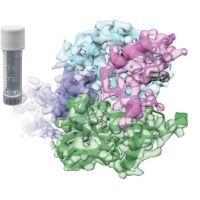Specification
| Organism | Homo sapiens (Human) |
| Expression Host | E.coli |
| Tag Info | N-terminal 6xHis-SUMO-tagged |
| Purity | Greater than 85% by SDS-PAGE |
| Uniprot ID | P51449 |
| Gene Names | RORC |
| Alternative Names | Nuclear receptor RZR-gammaNuclear receptor subfamily 1 group F member 3RAR-related orphan receptor CRetinoid-related orphan receptor-gamma |
| Expression Region | Full Length(1-518aa ) |
| Molecular Weight | 74.2 kDa |
| Protein Sequence | MDRAPQRQHRASRELLAAKKTHTSQIEVIPCKICGDKSSGIHYGVITCEGCKGFFRRSQRCNAAYSCTRQQNCPIDRTSRNRCQHCRLQKCLALGMSRDAVKFGRMSKKQRDSLHAEVQKQLQQRQQQQQEPVVKTPPAGAQGADTLTYTLGLPDGQLPLGSSPDLPEASACPPGLLKASGSGPSYSNNLAKAGLNGASCHLEYSPERGKAEGRESFYSTGSQLTPDRCGLRFEEHRHPGLGELGQGPDSYGSPSFRSTPEAPYASLTEIEHLVQSVCKSYRETCQLRLEDLLRQRSNIFSREEVTGYQRKSMWEMWERCAHHLTEAIQYVVEFAKRLSGFMELCQNDQIVLLKAGAMEVVLVRMCRAYNADNRTVFFEGKYGGMELFRALGCSELISSIFDFSHSLSALHFSEDEIALYTALVLINAHRPGLQEKRKVEQLQYNLELAFHHHLCKTHRQSILAKLPPKGKLRSLCSQHVERLQIFQHLHPIVVQAAFPPLYKELFSTETESPVGLSK |
| Form | Liquid or Lyophilization |
| Buffer | The default storage buffer is Tris/PBS-based buffer, 5%-50% glycerol if the delivery form is liquid. The lyophilization buffer is Tris/PBS-based buffer, 6% Trehalose, pH 8.0 if the delivery form is lyophilized powder. Please contact us if you have any special requirment. |
| Reconstitution | Please reconstitute protein in deionized sterile water and we recommend that briefly centrifuge thevial prior to opening the vial .We recommend aliquot for long-term storage at -20℃/-80℃. |
Background
| Relevance | Nuclear receptor that binds DNA as a monomer to ROR response elents (RORE) containing a single core motif half-site 5'-AGGTCA-3' preceded by a short A-T-rich sequence. Key regulator of cellular differentiation, immunity, peripheral circadian rhythm as well as lipid, steroid, xenobiotics and glucose metabolism. Considered to have intrinsic transcriptional activity, have some natural ligands like oxysterols that act as agonists (25-hydroxycholesterol) or inverse agonists (7-oxygenated sterols), enhancing or repressing the transcriptional activity, respectively. Recruits distinct combinations of cofactors to target gene regulatory regions to modulate their transcriptional expression, depending on the tissue, time and promoter contexts. Regulates the circadian expression of clock genes such as CRY1, ARNTL/BMAL1 and NR1D1 in peripheral tissues and in a tissue-selective manner. Competes with NR1D1 for binding to their shared DNA response elent on some clock genes such as ARNTL/BMAL1, CRY1 and NR1D1 itself, resulting in NR1D1-mediated repression or RORC-mediated activation of the expression, leading to the circadian pattern of clock genes expression. Therefore influences the period length and stability of the clock. Involved in the regulation of the rhythmic expression of genes involved in glucose and lipid metabolism, including PLIN2 and AVPR1A. Negative regulator of adipocyte differentiation through the regulation of early phase genes expression, such as MMP3. Controls adipogenesis as well as adipocyte size and modulates insulin sensitivity in obesity. In liver, has specific and redundant functions with RORA as positive or negative modulator of expression of genes encoding phase I and Phase II proteins involved in the metabolism of lipids, steroids and xenobiotics, such as SULT1E1. Also plays also a role in the regulation of hepatocyte glucose metabolism through the regulation of G6PC and PCK1. Regulates the rhythmic expression of PROX1 and promotes its nuclear localization . |
| Involvement in Disease | Immunodeficiency 42 (IMD42) |
| Subcellular Location | Nucleus |
| Protein Families | Nuclear hormone receptor family, NR1 subfamily |
| Tissue Specificity | RORC |
QC Data
| Note | Please contact us for QC Data |
| Product Image (Reference Only) |  |

